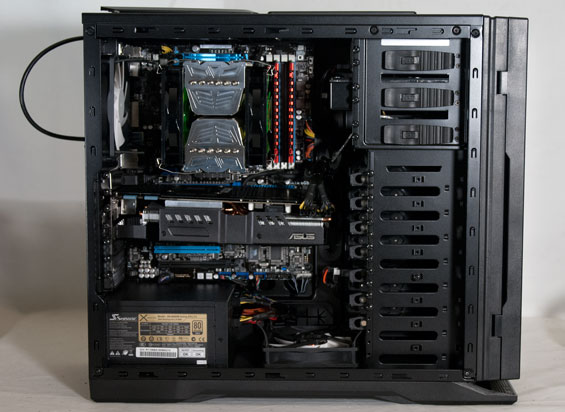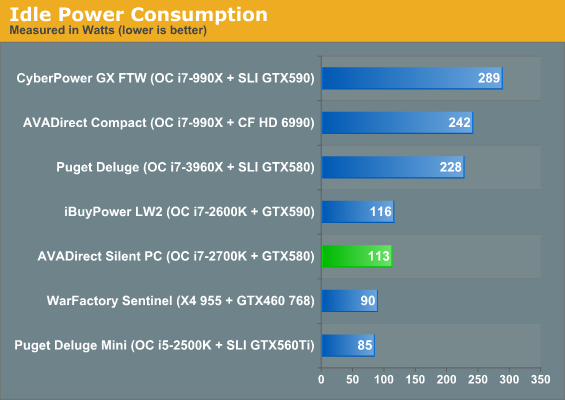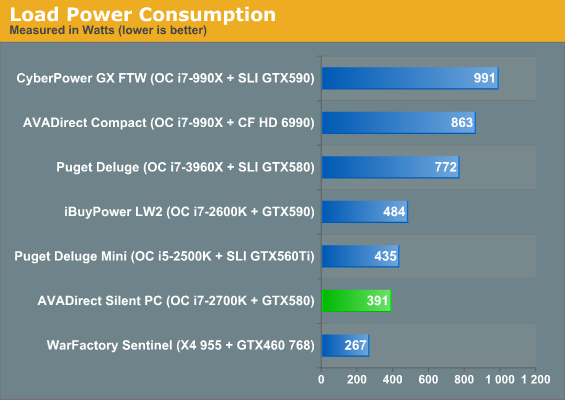AVADirect Silent Gaming PC: An Exercise in Balance
by Dustin Sklavos on January 30, 2012 5:30 PM ESTBuild, Heat, and Power Consumption
In discussing this build with AVADirect, I openly expressed my concerns about the use of NZXT's H2 enclosure. We reviewed the H2 enclosure some time ago and found it to be wanting, and during my meetings at CES I found the general sentiment pretty much lined up with our evaluation: it's a good idea, but it's flawed. AVADirect assured me that in their testing, they found the H2 was the best choice and the best deal for their build.

I was skeptical. The H2 feels like a choice motivated by cutting costs rather than performance; were it not for the design flaw (the front intakes are suffocated if the door is closed) it would certainly be close to an ideal boutique enclosure. Sure enough, though, you'll see AVADirect was able to make the H2 work. My guess is that the Prolimatech Megahalems cooler coupled with the bottom intake fan were able to go a long way towards redeeming the enclosure choice.
AVADirect also opted for a triple-slot custom cooler-equipped GeForce GTX 580 from ASUS. The stock cooler on the GTX 580 isn't bad at all (my SilverStone FT02 is able to keep my overclocked 580 from making much of a racket under load), but a better cooler certainly couldn't hurt. The Seasonic power supply and pair of Gelid silent fans on the heatsink help, too, but the Western Digital Green hard disk seemed like an unnecessary cut; I don't feel like the hard drive was going to be a major source of noise for the build.
Jarred was skeptical about a silent (or at least extremely low noise) build being possible with an overclocked i7 and a GTX 580, but I believed and still believe it could be done. Why do I say "still believe"? With all the case fans set on low, idle noise of AVADirect's build remains well below the 40dB "aggravation threshold," and even a GPU load doesn't noticeably affect noise levels. Unfortunately, the instant you stress test the CPU the Gelid fans start really kicking in and AVADirect's system goes to pot with a measured 42dB noise level from about a foot away. [Jarred: Isn't "very quiet" at least less than 30dB?]
And then there's my favorite whipping boy: the overclock. AVADirect should be commended for offering three overclock profiles with what appear to be manually tuned CPU voltages. So what's the problem? Simple: the voltages are set to manual and not offset mode. What this means is that the CPU voltage (and this is true of every overclock profile) never idles, leaving power and heat savings on the table.
At CES I had a conversation with iBuyPower's Ricky Lee, and he took me to task for being a bit harder on boutiques than I probably ought to be. His feedback wasn't unreasonable and I took it to heart, but one area where we disagreed was the importance of a well-tuned overclock. He argued that end users aren't going to notice how precise the overclock is, and as long as the computer functions properly and continues to function properly, it's not a major issue. My position is this: a wasteful overclock has the potential to make its presence known both on your power bill and, frankly, on the room temperature. Computers are extremely wasteful when it comes to power, and a fast machine can spew a lot of heat into a room in a hurry. Not allowing the CPU voltage to idle results in wasted power and increased heat.

While load temps are reasonable, idle temperatures are actually quite high for a custom desktop. The custom cooler on the GTX 580 is doing its job, but the CPU's cores should be 5-10C lower. How does this play out in power consumption?


Sandy Bridge is already a pretty frugal architecture, but Puget Systems is able to shave thirty watts off the idle power despite having two idle video cards. Is thirty watts a big deal in the grand scheme of things? Probably not, but it's wasteful all the same.










15 Comments
View All Comments
Galcobar - Monday, January 30, 2012 - link
42 dBA isn't anywhere near silent -- I understand it's near the floor for Dustin's measurement capabilities and something like Silent PC Review's 10 dBA lab is quite out of reach, but being near the floor of a loud room doesn't qualify for a silent or even low-noise computer.Noise measurement on these complete systems, particularly when reviewing systems attempting to sell themselves on noise reduction, would add a lot to these reviews. There's a gap in review sites I find: SPCR covers very quiet systems, but rarely deals with competent gaming builds, while gaming/enterprise reviewers rarely seem to give more than a superficial consideration to noise levels for these full builds.
Boutique builds produced four years ago with roughly equivalent TDP (higher CPU, lower GPU) and much less optimally-designed cases and CPU/GPU coolers were available in the 20-30 dBA range.
The criticism of the lazy overclock and poor component choices certainly seems accurate. For a partial comparison, Puget Systems has its i7 system using the Gelid Tranquilo, but equipped with Scythe Slipstream fans, and idles at 12 dBA (using 68W) and maxes out (Furmark + Prime 95) at 15 dBA (using 215W). Puget's Serenity uses a silent GPU, but Jarred noted the GTX 580 wasn't the problem with the AVADirect Silent.
However,
JarredWalton - Monday, January 30, 2012 - link
I think you missed the end of your comment, but I'm not sure about the comment that "Jarred noted the GTX 580 wasn't the problem with the AVADirect Silent PC". I think the GPU and CPU and case fans all contribute to the noise. It's hard for me to imagine anything with GTX 580 coming in under 30dB under load. Anyway, as I mentioned above, the limits of Dustin's equipment is 40dB, which is part of the reason he measures at 12". He can still hear an audible ramp up in system noise before the 40dB is crossed, though, so I'm guessing at idle the system is close to 30dB. I know my place gets down to about 30dB at night if I shut off all the PCs, but I have a different (better I suppose) SPL meter and I don't live in the CA suburbs.lurker22 - Tuesday, January 31, 2012 - link
Wow you must REALLY like PC gaming to spend $700 on a video card! lolTetracycloide - Tuesday, January 31, 2012 - link
Could have just flashed your firmware to 6970 and been just fine performance wise assuming you're only using one monitor. If you have multiple monitors and an eyefinity set-up maybe you need that kind of power but the 6950 would have been a silly thing to buy in the first place were that the case.GoGamerPro - Tuesday, February 7, 2012 - link
I have video games and computers for sale at http://gogamerpro.com